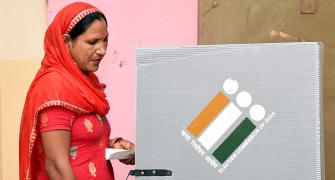 If an Indian SWF raised the return on the RBI's reserves by a percentage point, India's growth rate would go up by 0.2 per cent
If an Indian SWF raised the return on the RBI's reserves by a percentage point, India's growth rate would go up by 0.2 per cent
The Indian government is once again considering whether it should establish a Sovereign Wealth Fund with an initial endowment of $10 billion. Would that be a wise policy? The answer depends on the fund's objectives. Consider five possible objectives.
If the government believes that the Reserve Bank of India holds excess foreign exchange reserves that could and should be invested to generate a higher return, a case could be made for using a part of those reserves to establish a sovereign wealth fund.
The Reserve Bank's non-gold reserves are about $250 billion, or almost 20 per cent of India's GDP. If an Indian SWF increased the return on those reserves by one percentage point, India's growth rate would be increased by 0.2 percent, a small but significant figure.
On the other hand, the Reserve Bank has the capacity to increase the return on India's reserves without transferring them to an SWF.
From this perspective, the establishment of an SWF in India should be viewed as an investment decision for the government as a whole.
In a number of countries, the establishment of SWFs has been an extension of turf battles between central banks and finance ministries over foreign exchange policy, investment policies for international reserves, or the extent to which earnings on reserves should be used to finance the government.
Alternatively, if the government believes that its overall investment portfolio should be more diversified internationally, including the portion of that portfolio that is now managed by the central bank, establishing an SWF is one way of transparently accomplishing that objective. The case for doing so does not rest on whether or not India has a current account surplus.
When Singapore established Temasek Holdings and the Government Investment Corporation in 1974 and 1981 respectively, Singapore was running current account deficits.
Australia, Kazakhstan and Mexico are three other countries that have SWFs and persistent current account deficits.
Four US states have SWFs that invest abroad despite the fact that the United States has had a current account deficit for many years.
Moreover, many national and sub-national pension funds, which pose most of the same public policy issues as SWFs, invest abroad.
Of course, if India were to establish a SWF out of fiscal resources or by redirecting domestic investments abroad, India's external accounts would have to adjust accordingly, permitting larger gross capital inflows or a smaller current account deficit if the financing of the SWF were not to come from the Reserve Bank.
If India's objective in establishing an SWF were to permit the government to participate in strategic investments abroad, that could lead to a broader set of issues.
In some countries, the line between the public and private sectors is blurred. In other countries it is not.
In potential host countries, one of the major concerns about SWFs is that the governments will use them to pursue political or economic power objectives, or both at the same time, including in third countries such as in Africa. India could confront these concerns with its SWF.
Most SWFs do not seek to control the foreign financial or non-financial institutions in which they invest, or even to have a substantial influence on those institutions.
As with Russia and China, countries generally use other government-controlled entities to make controlling investments.
When SWFs do make controlling investments, or sometimes substantial non-controlling investments, they often encounter national security restrictions.
If the objective of India's SWF were to make strategic investments abroad alongside of investments by Indian private sector entities, that could lead to controversies because of concerns about cross-subsidies. Those concerns could spill over into trade policy disputes.
A major motivation behind the development of the Santiago Principles for SWFs was to increase the accountability and transparency of SWFs both at home and abroad in order to defuse some of the concerns about government investments. It follows that if India were to establish an SWF, it would be expected to adhere to the highest degree of compliance with the Santiago Principles.
Finally, if India's objective in establishing an SWF were to use it as a mechanism to redirect to the domestic economy funds that are currently invested abroad, for example international reserves, this cannot be done on a significant scale without adjusting India's macroeconomic policies.
With a heavily managed exchange rate, a country cannot repatriate via an SWF substantial funds without either affecting its exchange rate or otherwise adjusting monetary and fiscal policies to permit a larger current account deficit.
For a country such as India, with substantial investment needs and opportunities at home, the temptation is overwhelming to try to employ its foreign exchange reserves domestically, but the laws of economics do not permit such alchemy.
The choice of whether to establish a sovereign wealth fund is India's alone, but the government and citizens of India should be clear about its objectives and whether those objectives are compatible with other Indian policies and objectives, as well as with its international obligations.
The author is senior fellow, Peterson Institute for International Economics, Washington, DC. This column is based on his book, Sovereign Wealth Funds: Threat or Salvation, which will be published this month








